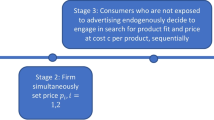Abstract
This paper addresses the determination and evaluation of optimal Internet marketing strategies when a firm is advertising on multiple websites. An optimization model is constructed for the determination of the optimal amount of click-throughs subject to a budget constraint. The underlying network structure of the problem is then revealed and exploited to obtain both qualitative properties of the solution pattern as well as computational procedures. In addition, three different pricing schemes used in Internet marketing are quantitatively compared and indices that can guide marketers to shift from one scheme to another are proposed. Finally, two numerical examples are constructed that demonstrate two paradoxes: (1) that advertising on more websites may reduce the total responses and (2) that advertising on more websites may reduce the click-through rate. Through the analysis of the network model, such puzzling phenomena are then quantitatively explained.
Similar content being viewed by others
References
R. Ahuja, T.L. Magnanti and J.B. Orlin, Network Flows: Theory, Algorithms, and Applications (Prentice-Hall, Upper Saddle River, New Jersey, 1993).
L. Baker, Adverse Perceptions Mask Compelling Realities, Salomon Smith Barney's Analyst Report, September, 2000.
D.P. Bertsekas and J.N. Tsitsiklis, Parallel and Distributed Computation (Prentice-Hall, Englewood Cliffs, New Jersey, 1989).
C. Bicknell, Net Ad Rates Continue to Fall. Wired News (January 25, 1999). http://www.wird.com/news/business/story/17520.html.
D. Braess, Uber ein Paradoxon der Verkehrsplanung, Unternehmensforschung 12 (1968) 258–268.
P. Chatterjee, D.L. Hoffman and T.P. Novak, Modeling the clickstream: Implications for web-based advertising efforts, Mark. Sci. 22 (2003) 520–541.
S. Dafermos, The traffic assignment problem for transportation networks, Transp. Sci. 6 (1972) 73–78.
S. Dafermos, An iterative scheme for variational inequalities, Math. Program. 26 (1983) 40–47.
S. Dafermos and A. Nagurney, On some traffic equilibrium theory paradoxes, Transp. Res. B 18 (1984) 101–110.
S.C. Dafermos and F.T. Sparrow, The traffic assignment problem for a general network, J. Res. Natl. Bur. Stand. 73B (1969) 91–118.
“Double Click 2002 Marketing Spending Index,” (2002) doubleclick.com.
“Double Click Q1 2004 Email Trend Report,” May (2004), doubleclick.com.
N. Elliott and N. Scevak, Online Advertising Through 2009, Jupiter Research, www.jupiterresearch.com.
F.S. Hillier and G.J. Lieberman, Introduction to Operations Research (McGraw-Hill, New York, New York, 1985).
Y.A. Korilis, A.A. Lazar and A. Orda, Avoiding the Braess paradox in non-cooperative networks, J. Appl. Probab. 36 (1999) 211–222.
Y. Liu, D.S. Putler and C.B. Weinberg, Is having more channels really better? A model of competition among commercial television broadcasters, Mark. Sci. 23 (2003) 120–133.
S. McKelvey, Braess's Paradox: A puzzler from applied network analysis, J. Undergrad. Math. Appl. 13 (1992) 303–312.
A. Nagurney, Network Economics: A Variational Inequality Approach, 2nd and revised edition (Kluwer, Dordrecht, The Netherlands, 1999).
A. Nagurney, Sustainable Transportation Networks (Edward Elgar Publishing, Cheltenham, England, 2000).
A. Nagurney, ed., Innovations in Financial and Economic Networks (Edward Elgar Publishing, Cheltenham, England, 2003).
A. Nagurney and J. Dong, Supernetworks: Decision-Making for the Information Age (Edward Elgar Publishing, Cheltenham, England, 2002).
A. Nagurney, J. Dong and D. Zhang, A supply chain network equilibrium model, Transp. Res. E 38 (2002) 281–303.
A. Nagurney, J. Loo, J. Dong, and D. Zhang, Supply chain networks and electronic commerce, Netnomics 4 (2002) 187–220.
A. Nagurney and S. Siokos, Financial Networks: Statics and Dynamics (Springer, Berlin Heidelberg New York, 1997).
Y.-H. Park and P. Fader, Modeling browsing behavior at multiple websites, Mark. Sci. 23 (2004) 280–303.
L. Shen, Debunking Banner Click-Through Myths. ClickZ Network -Solution for Marketers, http://www.clickz.com/, October 30, 2000.
L. Zhao and S. Dafermos, General economic equilibrium and variational inequalities, Oper. Res. Lett. 10 (1991) 369–376.
Author information
Authors and Affiliations
Corresponding author
Rights and permissions
About this article
Cite this article
Zhao, L., Nagurney, A. A network modeling approach for the optimization of Internet-based advertising strategies and pricing with a quantitative explanation of two paradoxes. Netnomics 7, 97–114 (2005). https://doi.org/10.1007/s11066-006-9006-y
Accepted:
Published:
Issue Date:
DOI: https://doi.org/10.1007/s11066-006-9006-y




